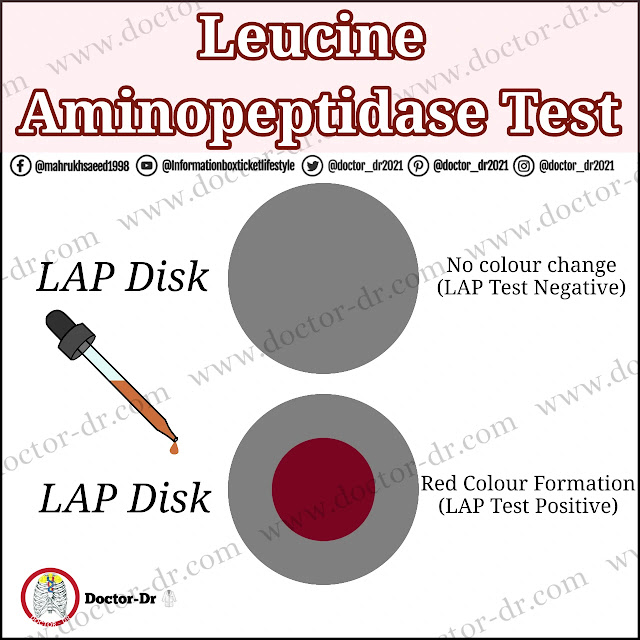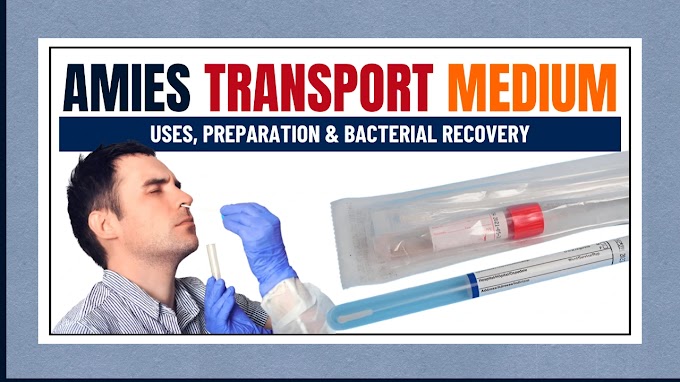Catalase-negative Gram-positive cocci bacteria are identified and differentiated using the LAP test. It is specifically utilised to differentiate between Aerococcus and Leuconostoc species and Streptococcus, Enterococcus, Pediococcus, and Lactococcus species.
Leucine residues from the N-terminus of proteins or/and peptides are hydrolyzed by leucine aminopeptidases, which are metallopeptidases. They are peptidase family proteolytic enzymes that assist in bacterial pathogenesis as well as protein metabolism for bacterial survival. Leucine aminopeptidases (LAP), however, are not synthesised by all bacteria. Therefore, detecting LAP production is a crucial method for classifying bacteria. In the microbiology lab, the LAP test is employed as a biochemical test to distinguish between groups of bacteria that produce leucine aminopeptidase and those that do not.
Table of Contents
- Objectives of LAP Test
- Principle of LAP Test
- Requirements for LAP Test
- Reagents
- Equipment
- Test Organisms (Sample Bacteria)
- Procedure of LAP Test
- Result and Interpretation of LAP Test
- LAP Test Positive Bacteria
- LAP Test Negative Bacteria
- Quality Control
- Precautions
- Applications of LAP Test
- Limitations of LAP Test
Objectives of LAP Test
- To evaluate bacteria's capacity to produce leucine aminopeptidases enzymes
- To distinguish and presumably identify Gram-positive cocci bacteria that lack catalase.
Principle of LAP Test
Leucine-p-naphthylamide components in the LAP disc are hydrolyzed by leucine aminopeptidase enzymes produced by bacteria. Leucine and free β- naphthylamide are produced by the LAP enzymes' hydrolysis of leucine-p-naphthylamide. In the presence of the cinnamaldehyde reagent (N, N-dimethylaminocinnamaldehyde), the free β- naphthylamide reacts to produce a brilliant pink or cherry red Schiff base, which indicates the LAP test was successful.
Requirements for LAP Test
Reagents
- LAP Disks (Disks impregnated with leucine-p-naphthylamide)
- LAP Reagent
0.01% p-N, N-dimethylaminocinnamaldehyde is used as a LAP reagent. The PYR reagent and LAP reagent are the same.
Composition of LAP Reagent:
N, N-dimethylaminocinnamaldehyde- 1.0 grams
Concentrated Hydrochloric Acid (HCl)- 10.0 mL
Distilled Water- 990.0 mL
Preparation of PYR Reagent:
- With continual stirring, slowly add 10.0 mL of concentrated HCl to 990.0 mL of distilled water along with 1.0 grammes of N, N-dimethylaminocinnamaldehyde.
- Make sure to thoroughly combine so that N, N-dimethylaminocinnamaldehyde dissolves.
- Store in a dark area between 2 and 8 °C.
3. Distilled water
Equipment
- Petri plates
- Bunsen burner
- Inoculating loop
- Forceps
- PPE and other general laboratory materials
Test Organisms (Sample Bacteria)
- Positive Control: Enterococcus faecalis ATCC 29212
- Negative Control: Aerococcus viridans ATCC 11563
Procedure of LAP Test
- Utilising forceps, insert an LAP disc into a sterile petri dish.
- Use sterile distilled water to wet the disc.
- Using a sterile inoculating loop, pick up 1 or 2 loops full of well-isolated sample bacteria and rub them onto the LAP disk.
- Incubate the plate aerobically for 5 minutes at room temperature.
- Add 1 to 2 drops of LAP reagent over the seeded LAP disk.
- After the reagent has been added for two minutes, watch for a change in colour.
Result and Interpretation of LAP Test
- After 2 minutes of adding the LAP reagent, the disc should develop a bright pink, cherry red, or reddish-purple colour. This indicates a positive response (LAP test positive).
- Pink colour development denotes a mild response and is seen favourably.
- After the addition of the LAP reagent, no colour change or formation of yellow or orange colour indicates a negative reaction (LAP test negative).
LAP Test Positive Bacteria
Streptococcus spp., Enterococcus spp., Lactococcus spp., and Pediococcus spp.
LAP Test Negative Bacteria
Leuconostoc spp., Aerococcus spp., Tetragenacoccus spp., etc. (Some Aerococcus spp. give variable results (Aerococcus urinae may give positive results))
Quality Control
Enterococcus faecalis ATCC 29212 results in the formation of bright pink (red) color over the disk within 1-2 minutes of the addition of the LAP reagent.
Aerococcus viridans ATCC 11563 doesn’t form pink or red color (doesn’t change color) after the addition of the LAP reagent.
Precautions
- Keep the LAP disc and reagent in a frigid, dark environment.
- Just lightly moisten the LAP disc with distilled water rather than completely submerging it.
- Rub the disc with a heavy inoculum that has been transferred. A faint pink colour may develop or falsely show up as negative when there is insufficient inoculum used.
Applications of LAP Test
- Detailed classification and identification of Gram-positive, catalase-negative cocci.
Limitations of LAP Test
- Catalase-negative, Gram-positive cocci bacteria are the only ones that can be used.
- False negative findings might be caused by insufficient inoculum.
- requires additional biochemical tests to confirm the identification of the sample bacteria because is insufficient for the complete identification of bacteria.



~1.webp)

.webp)

